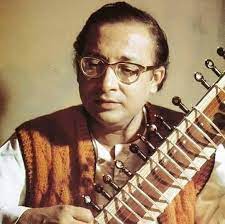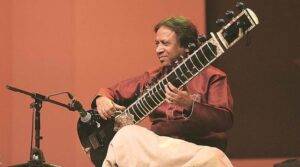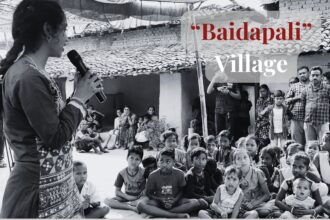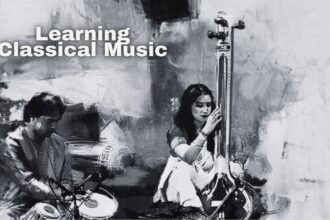While the concept of gharana as a social structure has its historical origins and development, the musical characteristics associated with a gharana often demonstrate significant deviations from their prescribed norms and expectations. In various forms of music, including khayal, dhrupad, and instrumental genres like sitar, sarod, flute, etc., it is common to find artists who have carved out their distinct styles within the framework of a gharana, deviating from the established styles and conventions. The phenomenon is particularly striking in sitar music, which is why the term “baaj” is more prevalent and emphasized in sitar music compared to the concept of gharana.
In the context of sitar music, “baaj” refers to a specific style or technique of playing the sitar. The term “baaj” can be understood as a musical pattern or a melodic framework used in the composition and improvisation of sitar music. Baaj encompasses a variety of elements, such as the choice of ragas (melodic scales), taal (rhythm cycle), and the specific ornaments, phrases, and patterns employed during the performance. A baaj can reflect the personal style, improvisational skills, and technical prowess of a sitarist, showcasing their mastery over the instrument and their understanding of the classical music tradition.Thus “baaj” in sitar music is a distinctive musical approach, technique, and improvisational style employed by a sitar player in their performance. Under the broader framework of gharana , a baaj focuses on the distinct style and approach of an individual artist. A musician may be trained in a particular gharana but develop their unique baaj, influenced by their mentor, their own creative instincts, and exposure to diverse musical experiences.
Exhibiting individual identity in baaj, the playing style and improvisational approach of a musician beyond the gharana or musical lineage is an important aspect of Indian classical music. They strive to develop their unique identity within that framework. Musicians express their individuality by interpreting ragas in their distinct manner. They may emphasize certain phrases, explore unique note combinations, or highlight specific melodic nuances that resonate with their musical sensibilities. Ornamentation techniques, such as meend (glissando), gamak (ornamented note), and khatka (grace notes), are employed to enhance the melodic beauty. Musicians infuse their personal touch and creativity by using ornamentation in unique ways, showcasing their individual style and aesthetic preferences.
However, the development of a unique baaj is a gradual process that evolves over years of dedicated practice, learning from gurus, and immersing oneself in the musical tradition. Each musician’s experiences, influences, and creative choices shape their individual identity within the broader framework of their gharana. Within the realm of sitar music, it is evident that every artist has developed their own unique style and identity, showcasing distinct musical expressions and individuality while still belonging to a particular gharana. To name ame a few , Vilayat Khan, developed a distinctive style that blended the traditional aspects of his gharana with innovative elements. He incorporated intricate taans (fast melodic passages) and unique meend (glissando) techniques, expanding the expressive range of the sitar. Khan’s mastery over complex rhythmic patterns and his ability to explore unconventional ragas showcased his individuality and set him apart within his gharana. Under the hands of the Ustad the traditional sitar underwent remarkable transformations.
Ravi Shankar, an iconic figure in the world of Indian classical music, provides an excellent example of a sitar maestro who forged his personal identity beyond his gharana (Maihar gharana). While he received extensive training in the Maihar gharana under his guru Allauddin Khan, Ravi Shankar’s artistic journey took him beyond the confines of a single gharana.The compositions he played were distinct from the traditional repertoire of the Maihar gharana. He experimented with new ragas, compositional structures, and musical ideas, incorporating his own creative influences. Through his compositions, Panditji showcased his individuality and innovative approach, offering a fresh perspective to sitar music that went beyond the traditional repertoire associated with his gharana. His sitar playing style was characterized by his impeccable control, expressive dynamics, and his ability to evoke deep emotions through his music.Through his innovations, collaborations, compositions, technique, and stage presence, Ravi Shankar exemplified how sitar maestros can develop their personal identity beyond their gharana.
Pandit Nikhil Banerjee, belonging to the Maihar Gharana, developed a deeply introspective and emotive playing style. He delved into the subtle nuances of ragas, exploring their emotive depths through delicate phrasing, subtle gamak ornamentations, and profound melodic improvisations. Banerjee’s introspective approach and his emphasis on emotional expression established his unique artistic identity within the broader context of the Maihar Gharana.

Ustad Shahid Parvez Khan, representing the Etawah Gharana, has garnered recognition for his dynamic and virtuosic sitar playing. He has expanded the technical possibilities of the sitar through intricate taans, complex rhythmic patterns, and intricate meend and gamak techniques. Ustadji’s lightning-fast improvisations, brilliant command over rhythm, and ability to effortlessly navigate complex ragas have established him as an artist with a distinctive baaj extending beyond the boundaries of his Gharana.

In Sitar music, numerous historical figures have demonstrated their unique musical identities by embracing elements of their gharana while incorporating diverse influences. This trend continues in the contemporary world. The contemporary world of sitar music witnesses a departure from the strict confines of specific gharanas as artists draw inspiration from multiple sources to create their distinct musical identities. Their virtuosity is demonstrated through their technical brilliance, expressive abilities, and willingness to innovate, culminating in the fusion of diverse elements and the emergence of unique playing styles that embody their artistic individuality. Contemporary sitar players prioritize virtuosity, placing emphasis on their technical skills, expressive abilities, and innovative approaches. They exhibit remarkable dexterity, precision, and speed, effortlessly maneuvering through complex melodic patterns, intricate ornamentations, and rapid rhythmic passages.
As the legacy of sitar music continues to evolve, the concept of baaj serves as a testament to the artistic prowess and creative vision of sitar maestros. It celebrates their unique contributions, their ability to transcend the limitations of gharanas, and their ongoing quest to redefine and shape the future of sitar music. The exploration and expression of baaj in sitar music embodies the essence of artistic freedom, innovation, and the ever-evolving nature of this enchanting musical tradition.








